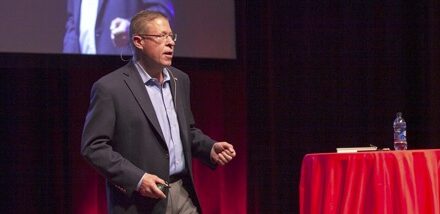In today’s competitive business environment, it is essential for our teams to be connected to our company mission.
Most companies have mission statements. Take yours and simplify it. Turn it into a one-sentence description of what your company does. Most mission statements have a lot of “political” jargon — these words keep our communities and investors happy, but they may get in the way of our teams having a real life, day to day knowledge of why the company does what it does.
So, take your mission statement and compress it into one sentence. This sentence should very simply state why your company does what it does.
Most of my career has been spent working for hospitals. The best one sentence for a hospital is “Our mission is to provide the best care for our patients.”
Don’t get caught up in other words… like quality, costs, patient satisfaction, community, investors, stakeholders, or … those other words serve to frame the mission. But, for a hospital, the mission is to provide the best care for our patients. Period.
I think all teams from anywhere in the organization can get behind that. It is easy for us to understand. There is not much more to explain. We provide the best care for our patients.
Here are the three steps to take with your team.
Step One. Share the short mission statement you just drafted. This is the one sentence version. It is okay to share the full, official company mission statement, and then share the short one sentence version. Let your team know you are doing this so that everyone can understand the company mission, at its simplest level. Let them know that the one sentence is so basic there is no reason for them or anyone to not fully understand what it means. Of course, you are going to have this conversation in a tactful and polite way. Answer questions. Perhaps you might even edit your one sentence after having a discussion with your team. Our teams have excellent insight, and they ask excellent questions. Feel free to be flexible and to learn from their comments and questions. Close this discussion with your question to the team. Ask your team if they know what your company does, why it is business, what its core mission is. (Hint: You should hear your team echo back to you a version of the one sentence mission statement summary. If not, you have to stay with Step One.)
Step Two. Ask each team member what he or she does in his or her job. Ask the question this way: “What do you get paid to do?” This is where things will start to get interesting. Most likely, many on your team will describe their job based on the tasks they perform or based on their job title. This is to be expected. Most of us spend most of our time at work doing a certain set of tasks, working a process, sitting or standing in a particular place, operating a piece of equipment, using a computer or other tools. We see ourselves through the lens of these tasks, these places and these tools.
As you discuss what each person’s role is making sure you share yours. I describe my role this way: “I am here to make sure we deliver excellent patient care and I do this by working with leaders and employees to make sure we have the right employees doing the right jobs.” This can be worded in any number of different ways. However, there is a bit of a formula to this. My role description is in two parts. First, I connect my role to the mission of the company. Right up front, at the start of my statement. The only reason I am here is because it is important for us to take care of patients. Or, to make trucks. Or, to sell shoes. Second, I connect my specific role to the mission. I am here to make sure we take care of patients by [insert a simple version of what you do]. Examples might be: …by making sure all our PCs are always in good working order…by making sure the building is secure for our employees, visitors and patients.
I think you get the idea. Stay focused on these two parts as you answer the question. The question again is: What is your job? The answer is mission + summary job detail.
Many of your team members won’t get this right away. Go around the room and have each read their answer. Listen and affirm for each how important what they have listed is to the organization. A fun way to do this is for each person to write their answer on a card, no names, and then shuffle the cards up and pass them out. As each card is read, have the team guess who is being described. This adds an element of fun to the exercise.
As the leader of the team, read yours last. Then discuss with the team what was different about yours and most of at the other answers. Some on the team may get defensive. Meaning, they will argue that what they wrote is definitive and is the best. That is okay. Move the discussion from a critique of specific responses to how do those individual responses connect to the company mission. Let the team know the reason for how you wrote your answer. Let them know it was done to model or show the team that even though what we each do hour-by-hour might be different. It all connects us to the ultimate mission of the company.
How your team absorbs this part of the dialog will be your guide as to the timing of taking the next step. Generally, covering steps 1 and 2 together at a staff meeting or a single workshop are sufficient. Altogether steps 1 and 2 might take 30 − 45 minutes. It is important to have a good and open dialog.
At your next staff meeting or at the next workshop session — preferably not more than 30 days have passed, perhaps less — you will then move to step 3.
Step Three. Allowing for some time to pass since step 2 you bring your team back together for step 3. Ask your team the same question you asked at step 2. That’s right. Ask the same question. What do you get paid to do?
Run the same exercise you ran in step 2. This time make sure each person writes their answers on a card and ask them to put their names on the cards. Give the team two or three minutes. Not much time. Don’t spend a lot of time rehashing the dialog from step 2. Just ask the question and collect the cards. Quickly, read what each person wrote. Keep the communication between you and your team open and transparent.
Thank them for participating. Let them know that discussing the company mission will continue to be an important part of what is discussed at staff meetings. Ask if there are any questions. Then move on to other items on your agenda.
Wrap it up. Back at your office, review the responses from your team. How many of your team responded the same way they had in step 2 and how many incorporated some aspect of the company mission in their response? This will help you gauge your team’s connection to mission.
I use a straight percentage. If half the team responded the same way and half connected to mission, then I would have a team that was 50% connected to mission. I really want my teams to have a mission connectedness score of 90% or greater.
If your team’s score is low, it only means they need additional education. It is up to you to provide that assistance to your team.
For me, this is so important, because if we are truly connected to mission it means we use a mission centered way to solve problems, to communicate, to support clients, customers, and other employees. It drives up my engagement. It makes the team and me more productive. It helps the business. It helps our customers. It improves our collective delivery on mission.
1) Do you know how well your team is connected to your company mission?
2) Can you see how being connected to mission improves delivery on mission?
3) Is understanding your team’s connection to mission worth the investment of time to run this (or a similar) exercise?
Latest posts by Philip Espinosa (see all)
- New Tires and Fear of Change - April 14, 2024
- Functional HR vs Organizational HR - February 18, 2024
- How is HR Like a Football Team - February 11, 2024












